A construction site safety plan is a detailed document outlining strategies to ensure safe working conditions, prevent incidents, and comply with regulatory standards on-site.
Importance of a Safety Plan in Construction
A construction site safety plan is crucial for ensuring the well-being of workers, reducing incident risks, and promoting a culture of safety. It helps comply with regulatory requirements like OSHA standards, preventing legal issues. By identifying hazards and outlining preventive measures, it minimizes accidents and ensures a safe working environment. A well-structured safety plan also enhances project efficiency and reduces potential financial losses from incidents. Additionally, it fosters trust among workers, clients, and stakeholders by demonstrating a commitment to safety. Regular updates and adherence to the plan ensure ongoing protection and adaptability to changing site conditions. Ultimately, a safety plan is essential for safeguarding lives and maintaining smooth project operations.
Purpose of a Site-Specific Safety Plan
The purpose of a site-specific safety plan is to address unique hazards and risks associated with a particular construction project. It ensures that all safety measures are tailored to the project’s specific conditions, such as soil excavation, fall protection, or trenching. The plan outlines the scope of work, identifies potential dangers, and details the policies and practices to mitigate them. It serves as a guide for all personnel, ensuring everyone understands their roles and responsibilities in maintaining a safe environment. By customizing safety strategies, the plan aims to prevent incidents, protect workers, and ensure compliance with regulatory requirements. It is a vital tool for promoting a proactive safety culture on-site.
Key Components of a Construction Site Safety Plan
A construction site safety plan includes essential elements like hazard identification, risk assessment, fall protection, PPE requirements, emergency response plans, and regulatory compliance measures.
Scope of Work and Project Overview
The scope of work and project overview section outlines the specific tasks, objectives, and deliverables of the construction project. It provides a clear description of the work to be performed, including timelines, milestones, and the overall project goals. This section ensures all stakeholders understand the project’s parameters and how safety protocols will be integrated into each phase. By detailing the project’s extent, potential hazards can be identified early, and appropriate safety measures can be planned. This foundational element of the safety plan helps ensure compliance with regulations and sets the stage for a safe working environment throughout the project’s duration.

Hazard Identification and Risk Assessment
Hazard identification and risk assessment are critical components of a construction site safety plan. This process involves systematically identifying potential hazards, evaluating their risks, and implementing controls to mitigate them. Common hazards include falls, trench collapses, equipment malfunctions, and exposure to hazardous materials. The assessment considers the likelihood and severity of incidents, ensuring proactive measures are taken. By documenting these findings, the safety plan provides clear guidelines for safe work practices, emergency procedures, and PPE requirements. Regular updates to the risk assessment ensure evolving site conditions are addressed, fostering a safer environment for all personnel and compliance with regulatory standards.
Fall Protection and Prevention Measures
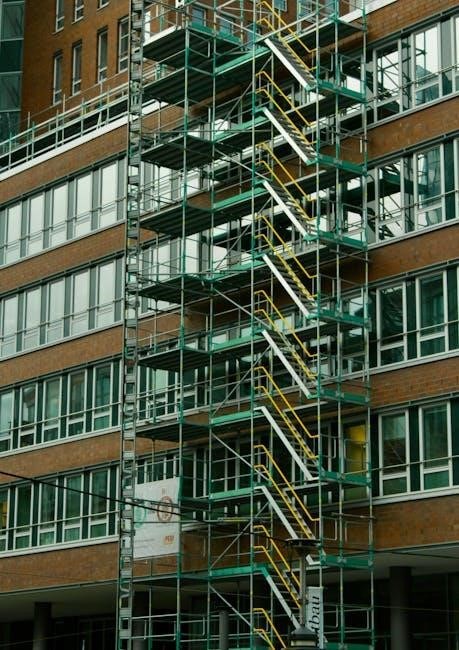
Fall protection and prevention measures are essential in construction site safety plans to minimize risks of falls, a leading cause of injuries and fatalities. These measures include installing guardrails, safety nets, and fall arrest systems like harnesses and lanyards. Proper equipment installation, regular inspections, and maintenance are critical. Additionally, training workers on fall hazards, equipment use, and rescue procedures is mandatory. Supervisors must enforce safe work practices and ensure compliance with fall protection standards. Personal Protective Equipment (PPE) such as hard hats and non-slip footwear further enhances safety. Regular audits and inspections help identify and address potential fall hazards, ensuring a proactive approach to preventing incidents and protecting workers at heights.
Personal Protective Equipment (PPE) Requirements
Personal Protective Equipment (PPE) is a critical component of construction site safety, ensuring workers are protected from specific hazards. The safety plan outlines mandatory PPE, such as hard hats, safety glasses, gloves, and high-visibility clothing. Respiratory protection is required in environments with airborne contaminants, while steel-toe boots prevent foot injuries. Employers must provide accessible PPE and train workers on proper usage, fitting, and maintenance. Regular inspections ensure PPE is in good condition, and defective items are promptly replaced. Compliance with PPE requirements reduces injury risks, enhances worker confidence, and fosters a culture of safety. Adherence to these standards is enforced through site audits and ongoing monitoring by safety personnel.
Emergency Response and Evacuation Plan
An emergency response and evacuation plan is a critical component of a construction site safety plan, ensuring prompt and organized actions during unforeseen incidents. This plan outlines procedures for emergencies like fires, medical incidents, or natural disasters, detailing escape routes, emergency exits, and assembly points. It assigns roles and responsibilities to site personnel, such as first responders or evacuation coordinators. Effective communication methods, like alarms or public address systems, are specified to alert workers. Regular drills are conducted to familiarize the team with evacuation protocols; The plan also includes procedures for accounting for all personnel after evacuation and providing assistance to those with disabilities. Ensuring preparedness and quick response can prevent injuries and save lives, making this plan indispensable for site safety.
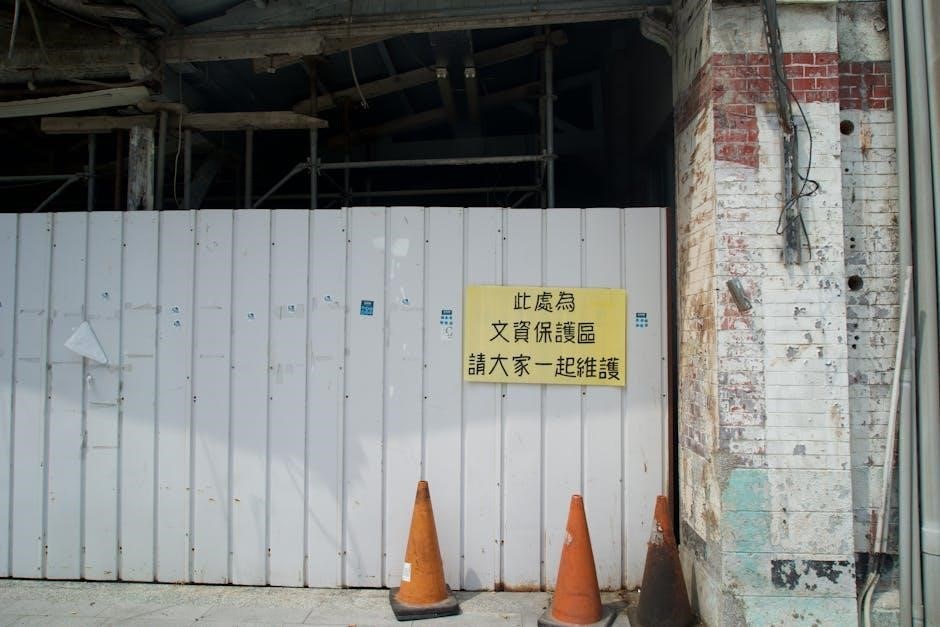
Regulatory Compliance and Standards
Construction site safety plans must adhere to OSHA and state regulations, ensuring compliance with legal standards to minimize risks and protect workers through documented safety protocols.
OSHA Requirements for Construction Safety
OSHA requires construction sites to implement specific safety measures to protect workers from hazards. This includes fall protection systems, proper use of personal protective equipment (PPE), and safe trenching practices. Employers must conduct regular site inspections, maintain accurate injury records, and provide training on hazard recognition and safety protocols. Compliance with OSHA standards ensures adherence to federal regulations, reducing workplace accidents and legal liabilities. Site-specific safety plans must align with OSHA guidelines, detailing procedures for emergency response, fire prevention, and equipment safety. Failure to comply can result in penalties, emphasizing the importance of integrating OSHA requirements into all aspects of construction safety planning and operations.
State and Federal Regulations for Site Safety
Both state and federal regulations play a crucial role in ensuring construction site safety. Federal regulations, such as those set by OSHA, provide a baseline for safety standards nationwide. State-specific laws may add additional requirements, making compliance a dual effort. These regulations often mandate permits, inspections, and documentation to verify adherence to safety protocols. Contractors must familiarize themselves with both levels of regulations to avoid penalties. Regular audits and inspections are typically required to ensure ongoing compliance. By adhering to these regulations, construction sites can minimize risks, protect workers, and maintain legal operation. Compliance is not only a legal obligation but also a commitment to workplace safety and accountability.
Implementation and Monitoring of the Safety Plan
Effective implementation involves developing site-specific safety practices, assigning roles, and documenting procedures. Ongoing training, toolbox talks, and regular inspections ensure adherence to the plan. Continuous monitoring identifies gaps, enabling adjustments to enhance safety and compliance, fostering a proactive approach to risk management and worker well-being.
Site-Specific Safety Practices and Policies
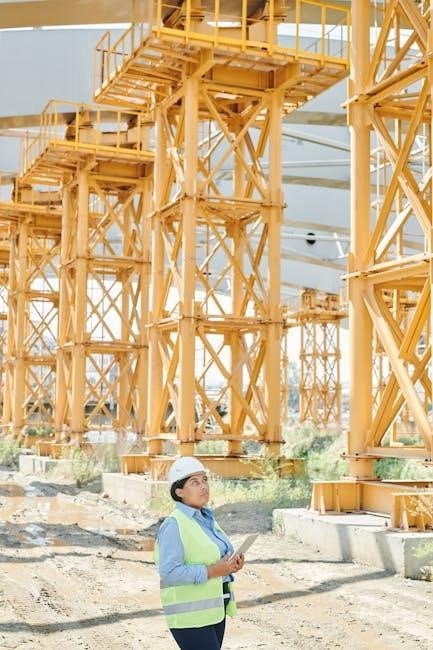
Site-specific safety practices and policies are tailored to address the unique risks and conditions of each construction project. These practices include hazard identification, risk assessments, and the implementation of control measures to mitigate potential dangers. Policies may encompass rules for PPE usage, fall protection, and emergency response procedures. Compliance with OSHA and local regulations is mandatory, ensuring all safety protocols are adhered to. Regular site inspections and audits are conducted to monitor adherence to these policies. Training and orientation programs are also integral, ensuring all workers understand and follow safety guidelines. By adapting policies to the specific site, contractors can create a safer working environment and reduce incident risks effectively.
Roles and Responsibilities of Site Personnel
Defining clear roles and responsibilities is essential for ensuring a safe construction site. The project manager oversees overall safety compliance and resource allocation, while the safety officer enforces regulations and conducts regular inspections. Supervisors monitor daily activities, address hazards, and ensure workers follow safety protocols. Workers are responsible for adhering to safety guidelines, using PPE, and reporting incidents or risks. Subcontractors must comply with the site-specific safety plan and communicate hazards specific to their tasks. Collaboration and accountability among all personnel are critical to maintaining a safe working environment. Clear communication and documentation of roles ensure that everyone understands their duties, promoting a culture of safety and reducing potential risks effectively on-site.

Training and Orientation for Construction Site Safety
Effective training and orientation are crucial for ensuring all personnel understand safety protocols, site-specific hazards, and emergency procedures before starting work, promoting a safe and informed workplace.
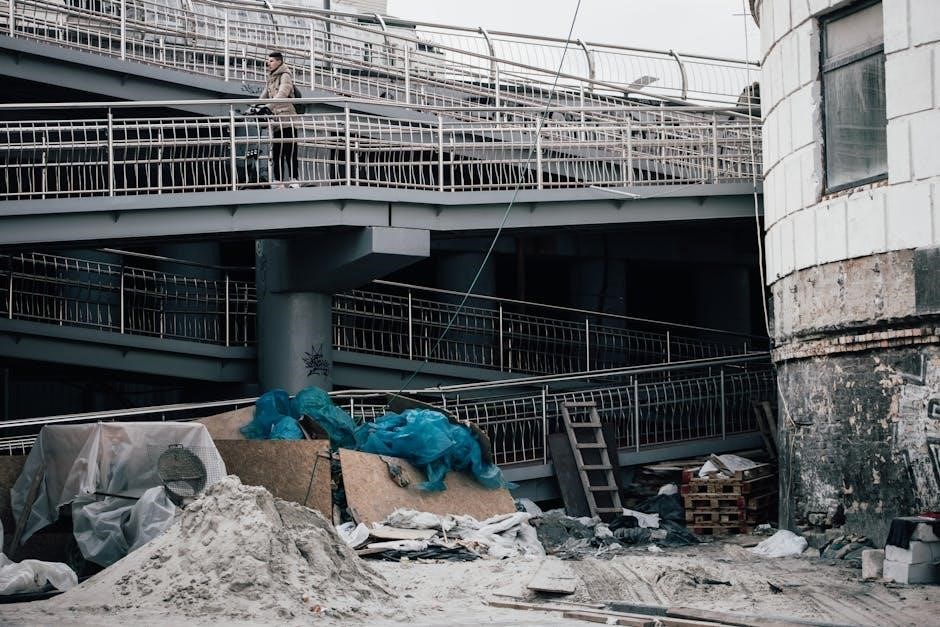
Worker Orientation and Induction Process
The worker orientation and induction process is the first step in ensuring all personnel are aware of site-specific safety protocols and expectations. This program includes a comprehensive review of the safety plan, emergency procedures, and hazard identification; All workers must attend an induction session before starting work, where they receive detailed information about the site’s safety policies and procedures. The induction also covers the use of personal protective equipment, fall protection measures, and fire prevention strategies. A written record of attendance and understanding is maintained for compliance purposes. Supervisors are responsible for ensuring that all workers understand their roles in maintaining a safe working environment before commencing their tasks.
Ongoing Safety Training and Awareness Programs
Ongoing safety training and awareness programs are essential for maintaining a safe and informed workforce. These programs provide regular updates on safety protocols, new regulations, and emerging risks. Training sessions are conducted periodically, covering topics such as hazard identification, fall protection, and emergency response. Toolbox talks and safety meetings are integral parts of these programs, ensuring continuous communication and reinforcement of safe practices; Additionally, refresher courses are mandated to keep workers up-to-date with the latest safety standards and equipment. The goal is to foster a culture of safety and accountability, reducing incidents and ensuring compliance with regulatory requirements. Supervisors and safety officers monitor participation and assess the effectiveness of these programs.
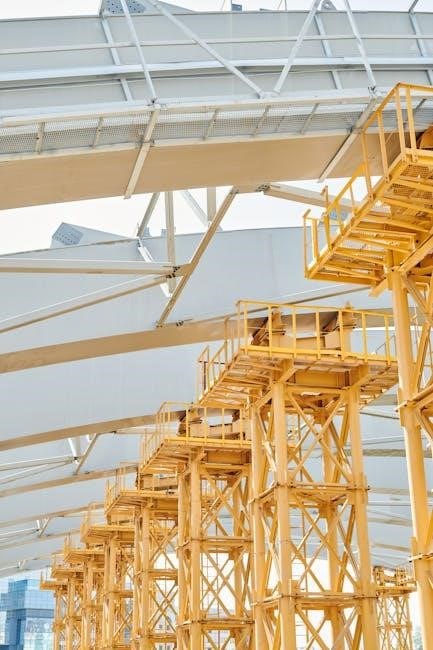
Documentation and Recordkeeping
Accurate documentation and recordkeeping are critical for tracking incidents, inspections, and compliance. Maintain detailed records of safety inspections, incident reports, and training programs to ensure accountability and compliance.
Incident and Injury Reporting Procedures
Effective incident and injury reporting is essential for maintaining a safe construction site. All incidents, regardless of severity, must be documented promptly and accurately. This includes completing incident report forms, detailing the cause, impact, and corrective actions. Supervisors and safety officers should ensure that injured workers receive immediate medical attention and that incidents are investigated thoroughly. Proper documentation helps identify trends, prevent future incidents, and ensures compliance with legal requirements. Records should be maintained securely and made available for audits or inspections. Regular reviews of incident reports can lead to improved safety measures and a safer working environment. Timely reporting also supports worker compensation claims and legal compliance.
Site Inspection Checklists and Audit Trails
Site inspection checklists and audit trails are crucial tools for ensuring compliance with safety standards and identifying potential hazards. These documents provide a structured approach to evaluating site conditions, equipment, and worker practices. Checklists typically include items such as fall protection measures, PPE usage, and equipment maintenance. Audit trails involve documenting the findings of inspections, corrective actions taken, and follow-up measures to ensure compliance. Regular inspections and detailed documentation help maintain accountability and transparency, while also providing a record of safety performance over time. These tools are essential for proactive risk management and continuous improvement of site safety practices.
A well-structured construction site safety plan is essential for ensuring the well-being of workers and the success of a project. By outlining hazard identification, risk assessment, and preventive measures, it creates a safer working environment. Regular updates and adherence to regulatory standards, such as OSHA requirements, are critical for maintaining compliance. The plan also serves as a guide for emergency response and documentation, ensuring preparedness and accountability. Ultimately, a comprehensive safety plan not only protects lives but also enhances project efficiency and reputation. Investing in a detailed and site-specific safety plan is a commitment to safety, legal compliance, and the overall success of the construction project.